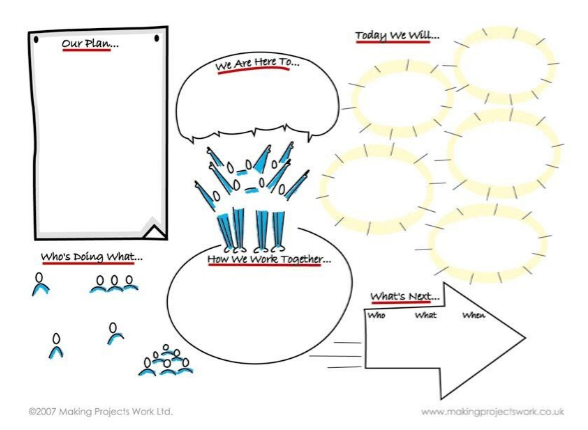Dr Penny Pullan, Author of "Making Workshops Work: Creative Collaboration for Our Time", explains how workshops can build on the best practices of the past as well as overcome new barriers.
During lockdowns, huge numbers of staff learned how to use virtual technology to interact with colleagues. The only way of meeting was via technology. Teams and Zoom became ubiquitous. During virtual sessions, stuck in little rectangular boxes on screen, we dreamed about the day when we'd be back with our colleagues, able to look them in the eye, rather than having to force ourselves to gaze into a camera lens to “make eye contact”. Oh, to see the whites of their eyes and to be able to pick up body language at a glance! But now we are faced with workshops in the new normal, where some are at home and some are in the office. How do we make these workshops work?
It makes sense to build on the best practices of the past, as well as overcome new barriers. (There is one huge barrier in hybrid workshops, which I’ll tackle later in this article. This means that going back to the office might not be the treat that we anticipated.) But first, let's ensure we do all the great things that the best workshop leaders have always done. One of these is providing clarity. This is particularly important when people are not together in person. I suggest using my Magic 6TM statements for clarity as you plan a workshop, as well as at the start:
- “We are here to..." What’s the point of your workshop, at a high level?
- "Today, we will..." Here I give four or five more detailed objectives.
- "Our plan..." This gives the overall time plan for the workshop.
- "Who's doing what?" This covers the roles people will play, including remote participants.
- "How we work together..." This is really important as it sets the tone for the session: how the group will work together. Talking through potential challenges up front makes for a smoother workshop.
- "What's next?" How will you capture actions and follow them up?

Design your workshop for collaboration by planning for engagement and interaction. Let's leave slideshows in darkened rooms back in the past! When you bring people together, engage them and get them interacting with each other instead.
Now for that huge challenge with hybrid workshops... hybrid workshops lack a level playing field. Without one, your workshop is set up for failure. It just isn’t possible to collaborate effectively. Those who join remotely will be immediately at a disadvantage, and not just because it’s often hard for them to hear the discussion. Those in the room can easily pick up on the dynamics and nuances of conversation. They can glance around, see body language and understand where people are coming from, in a way that isn’t quite the same virtually. Unless you take active steps to level the playing field, you will end up with remote participants feeling left out.
So, what are the options for levelling up the playing field?
- Bring an awareness of any remote people into your physical space. One idea for this is to place life-sized, cardboard cut-out cartoons of remote participants on chairs around the table, one cut-out per chair. This stops people in the room from forgetting about those people who are remote. You can do something similar with name tents, but with less impact.
- Allocate an in-room buddy for each remote participant, to answer any questions that they have, to bear them in mind and as an extra point of contact.
- Use virtual meeting technology for everyone in a hybrid workshop, as many large organisations are doing.
Perhaps you could use all three? Whichever options you pick, think remote first to help keep the playing field level. Ask the remote people first each time you go around the group. Check in with them more than you would those in the room, as a glance won’t suffice.
While we're all looking forward to returning to the office, at least in part, don't assume that this will naturally make collaboration easier. Instead, to make your workshops work, design for collaboration up front, across the remote/in-room divide. Build on good practice from the past. Make sure that you have complete clarity, using the Magic 6TM statements as you prepare and at the start of any workshop. Design in engagement and interaction. Deal with the elephant in the room: the lack of a level playing field. Over to you - all the best with your workshops.
Dr Penny Pullan’s new book: "Making Workshops, Work: Creative Collaboration for Our Time'' became a bestseller on launch day (PIP, July 2021). It’s full of tips for workshops, whether in-person, hybrid or remote. Her previous book was the CEO Today Top Five Book for Lockdown: "Virtual Leadership, Practical Strategies for Getting the Best Out of Virtual Work and Virtual Teams" (Kogan Page, 2016).
Penny's hybrid workshop experience goes back to 9/11 when she was grounded for months and had to run the kick-off for her first ever international programme virtually. Since then, she's founded www.makingprojectswork.co.uk, where she supports organisations who wish to take their workshops from hard slog to creative collaboration, whether in-person, hybrid or virtual.











